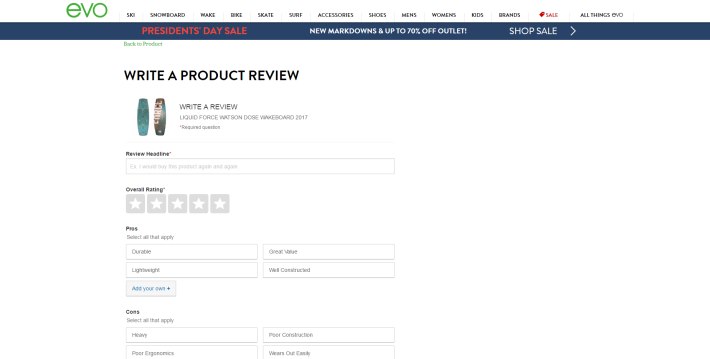Author: Elyse Dupre / Source: DMN How the outdoor gear and apparel retailer has expanded its use of customer reviews over the past 10 year
How the outdoor gear and apparel retailer has expanded its use of customer reviews over the past 10 years.

Marketers today have no shortage of powerful tools. From AI to VR, they can access numerous solutions to help drive engagement and conversion. But the most powerful tool, arguably, isn’t new or cutting-edge. It’s the time-honored customer review.
According to the 2016 “Local Consumer Review Survey” by local SEO company BrightLocal, 84% of consumers polled say they trust online reviews as much as a personal recommendation. And “The ROBO Economy”—a report produced by user-generated content solution provider Bazaarvoice—states that 54% of online shoppers surveyed say they read reviews before buying.
Outdoor gear and apparel retailer evo started utilizing customers’ ratings and reviews about 10 years ago and has continued to evolve its user-generated content strategy to drive authenticity and sales.
Gearing up with new technology
When evo’s director of e-commerce Nathan Decker saw other retailers leveraging customer reviews back in 2006, he wanted to find a way to tap into evo’s own community of outdoor sports enthusiasts. So, that year, he decided to implement PowerReviews’ ratings and reviews software and incorporate customer feedback into evo’s website.
“I don’t know if you could survive as an e-commerce retailer without reviews,” Decker says. “It’s an expected part of that digital shopping experience.”
Through the software, evo is able to host rating and review templates on its website and ask customers for product feedback. One template, for instance, might ask customers to list a product’s pros and cons, the best uses cases for that product, and whether they would recommend the product. evo can also solicit general comments, star ratings, and images and videos through this technique.
Because these templates are category-specific, the questions can vary depending on the product. A review template for snowboarding boots, for instance, might ask for sizing and width descriptions while a template for a mountain bike might ask for preferred cycling styles (such as speed or comfort).
After a customer submits a review, PowerReviews uses fraud detection software to track suspicious activity patterns. It can also identify a reviewer’s IP address and device to determine whether that reviewer is submitting multiple phony claims.
Once the review has been verified, PowerReviews displays it on evo’s search-result or product-details page, optimizing it for SEO. On the search results pages, customers can see the number of reviews a product has, as well as its overall star rating. They can also opt to filter their search results by products with the highest star rankings. The product pages feature a bit more detail, including reviewers’ comments and product descriptions.
Not only can evo collect reviews written by its own customers, but it can also collect reviews written by other brands’ customers. The reviews just have to describe a product featured in the evo catalog and come…

COMMENTS